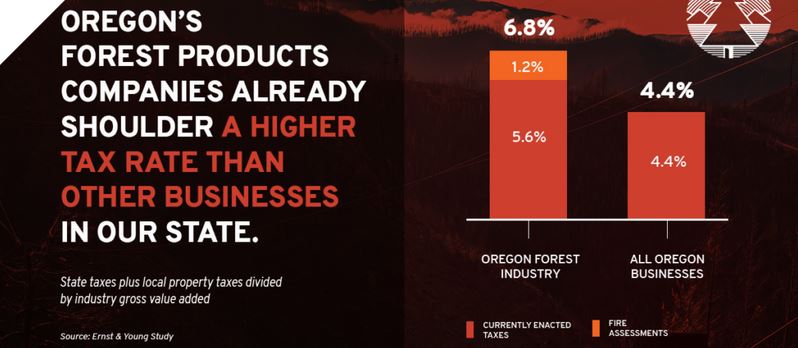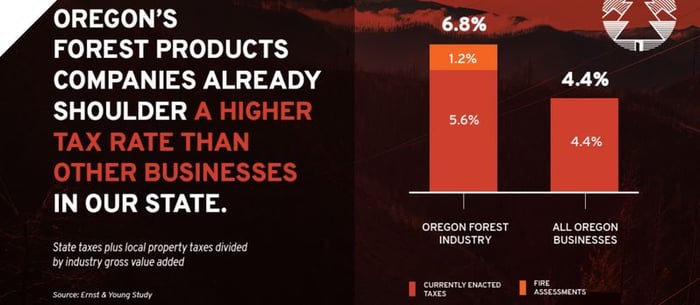3 min read
New Study Reveals Excessive Tax Burden on Oregon’s Forest Sector
Forest2Market
:
May 5, 2021

The Oregon Forest & Industries Council (OFIC) recently released a groundbreaking report from national accounting firm Ernst & Young detailing the total tax burden on the private forest sector in Oregon. The report’s primary finding concludes the Oregon forest sector pays more than 1.5 times more on average than other Oregon businesses.
The report calculated the total tax burden by aggregating all taxes paid by the sector, including property taxes, income taxes, small tract forestland taxes, corporate income and excise taxes, fire assessments and privilege taxes. All told, in 2019, Oregon’s forest sector contributed over $142 million to state tax coffers. The report is the first comprehensive analysis to aggregate forest industry tax burdens and comes at a time when the Oregon Legislature is considering legislation that would further increase taxes on the state’s forest sector.
 Image Courtesy of Oregon Forest & Industries Council
Image Courtesy of Oregon Forest & Industries Council
Todd Payne, Chairman of the Oregon Forest & Industries Council’s Board of Directors and Chief Executive Officer for Seneca Family of Companies, said: “We’ve just suffered the worst wildfire season in history – private forestland owners lost over 400,000 acres in the Labor Day fires and we are actively working to restore and replant those lands at significant costs. Many of our rural communities are suffering multiple extreme hardships as they struggle to rebuild post-fire while the global pandemic and business shutdowns are taking enormous tolls. This report unequivocally concludes our sector already pays more than its fair share in taxes and it vindicated our sense that additional tax increases are motivated more by philosophical differences about forest management than they are by any sense of tax equity.”
As one of the leading softwood lumber and plywood producers in the nation, Oregon’s forest sector is one of the state’s cornerstone industries and serves as the economic backbone for many rural counties. Lane and neighboring Douglas county together encompass over a quarter of the state’s annual timber harvest, and over 80% of this timber is harvested from privately owned forestlands.
“Given the report’s findings, we now know that legislation under consideration in the 2021 legislative session would effectively double the total taxes currently paid by the forest sector,” said Adrian Miller, Chair of the Oregon Forest & Industries Council’s Tax Committee and Director of Public Affairs for Rayonier. “That would increase the forest sector’s effective aggregate tax rate to nearly three times more than other Oregon businesses pay. At a time when the latest state revenue forecast indicates the Legislature has nearly $800 million more to work with this session than it originally thought and has billions of dollars in reserves, doubling the tax burden on the forest sector seems unnecessary.”
In 2020, Oregon Business and Industry commissioned Ernst & Young to quantify the impact of recently enacted state tax programs on the total tax burden carried by Oregon businesses. That report concluded in the past few years, the Oregon Legislature has increased the tax burden on businesses by 41%.
A Shortsighted View
As legislators follow the money, they are increasingly taking aim at corporate landowners who have purchased productive Oregon timberland over the last two decades. “The profits are concentrated with a small number of companies controlled by real estate trusts, investment funds and wealthy timber families. Small timber owners, who grow forests that are older and more biologically diverse than what corporate owners manage, have sold off hundreds of thousands of acres,” wrote ProPublica in a 2020 piece on Oregon’s forest industry communities.
The piece continues, “In western Oregon, at least 40% of private forestlands are now owned by investment companies that maximize profits by purchasing large swaths of forestland, cutting trees on a more rapid cycle than decades ago, exporting additional timber overseas instead of using local workers to mill them and then selling the properties after they’ve been logged.”
ProPublica goes on to blame this ownership structure - and working forests in general – for a number of environmental and social ailments, even noting that “…younger trees don’t store carbon dioxide as well as older ones.” This simply isn’t true, as the science has demonstrated.
But like much legislation, there are unintended and oftentimes negative consequences that impact other essential stakeholders. A majority of western Oregon’s private timberland is owned by Non-Industrial Private Forest (NIPF) landowners – many of whom manage just a few dozen acres not because they’re chasing quick profits, but because of a love for preserving forest and wildlife habitats. Penalizing landowners via excessive taxes is bad for all forest ownership groups, which is ultimately bad for forests.
When forestland ownership becomes uneconomical, the risk for converting the land to other uses increases and with such conversion, the forest is lost forever. Therefore, keeping the economics of forest ownership strong for all stakeholders is a key component in preserving the proven relationship between environmental and economic interests of the forest.





